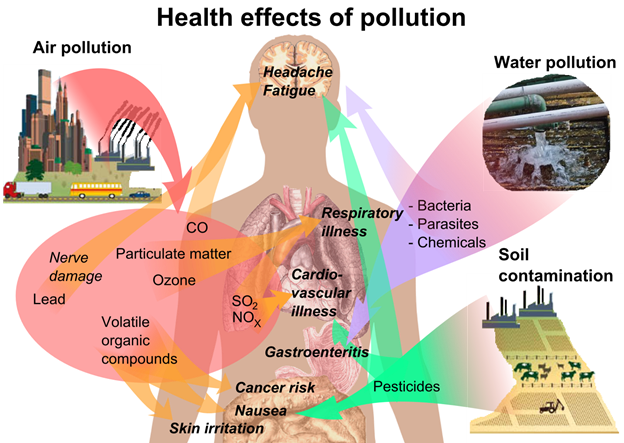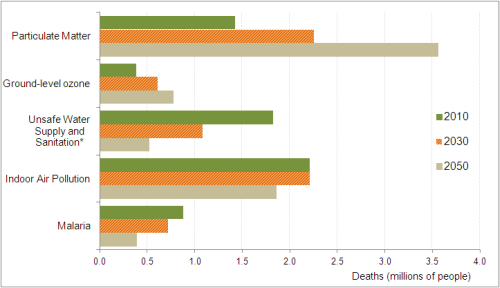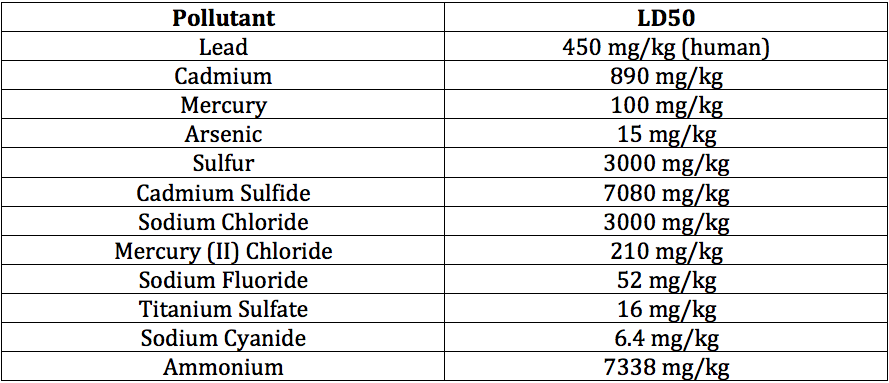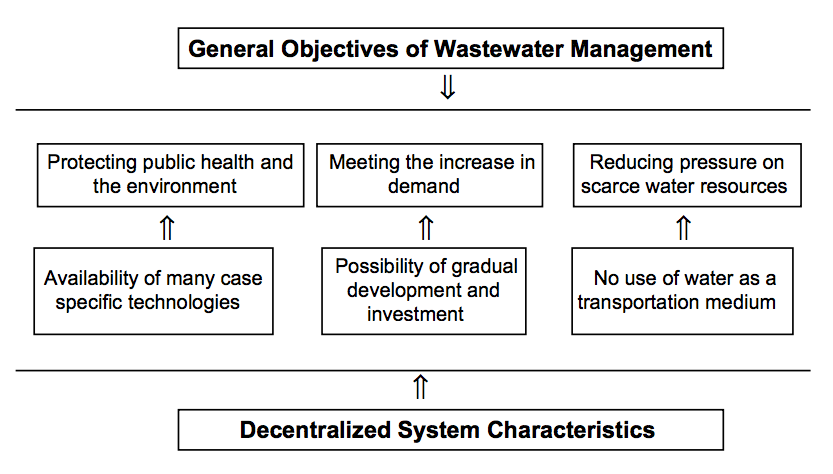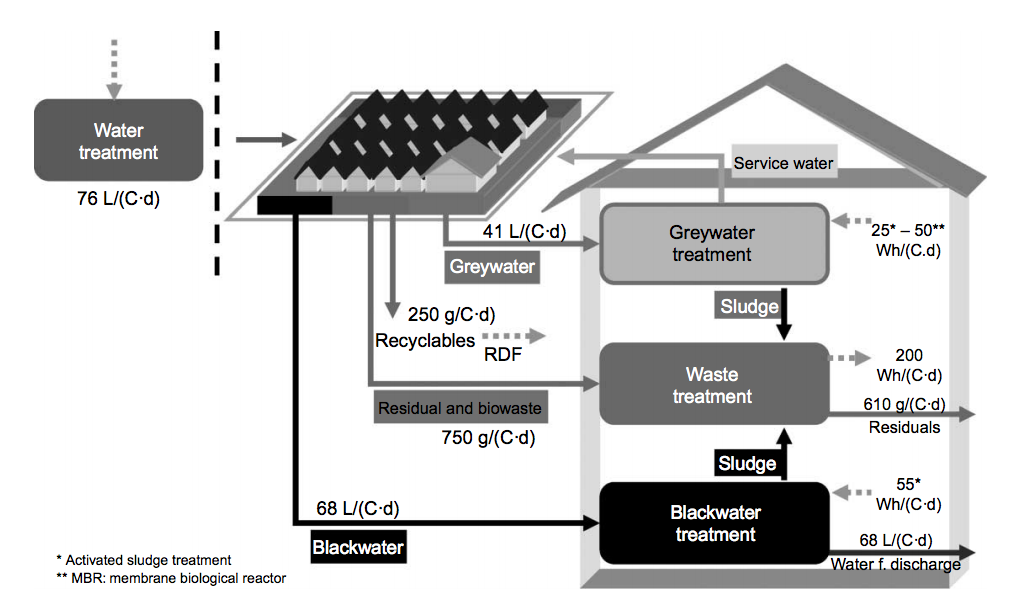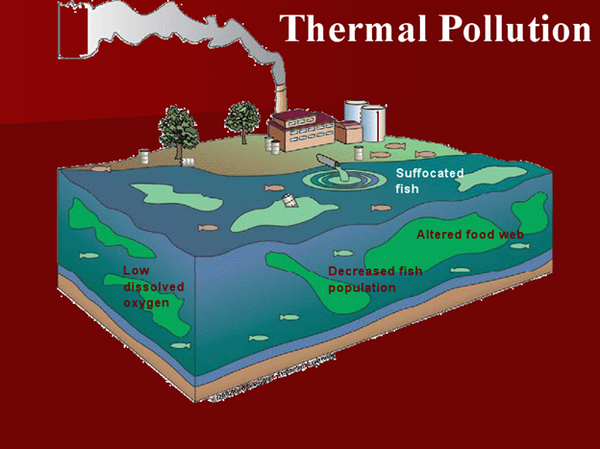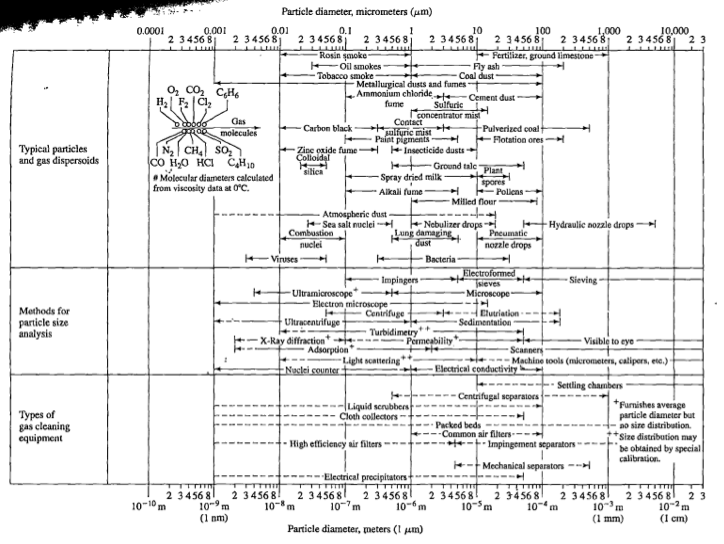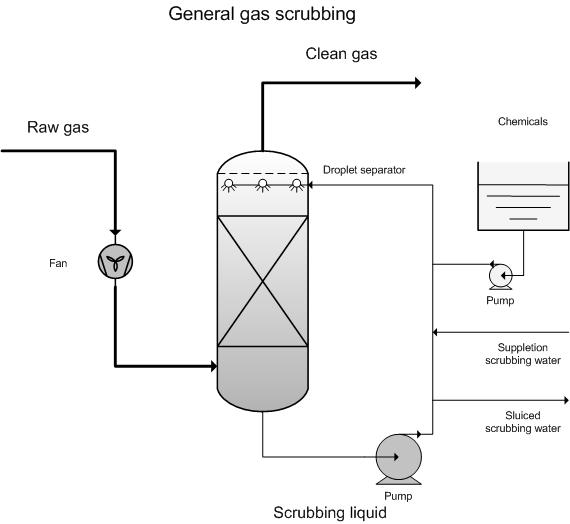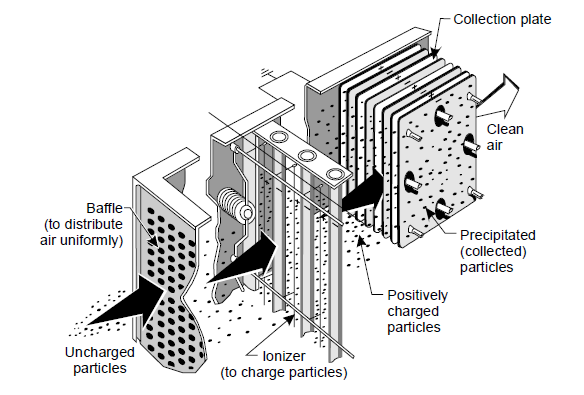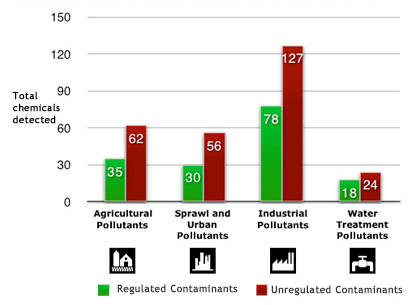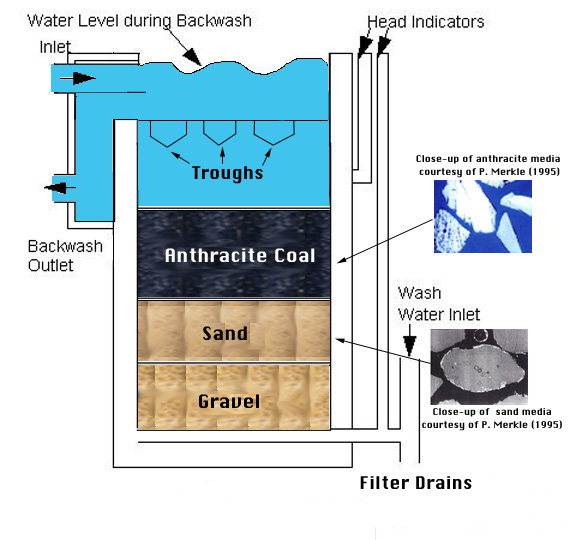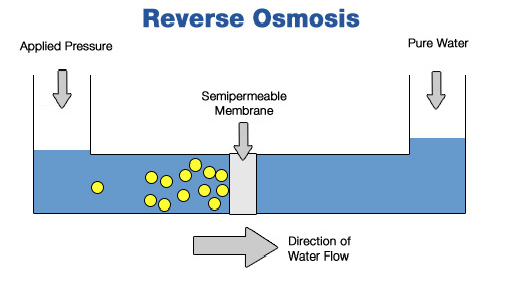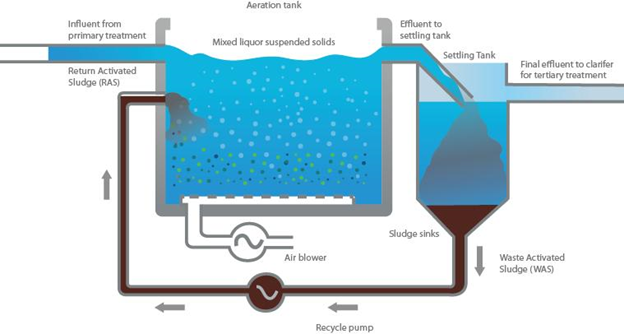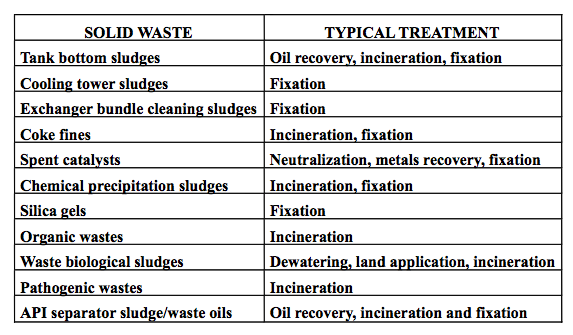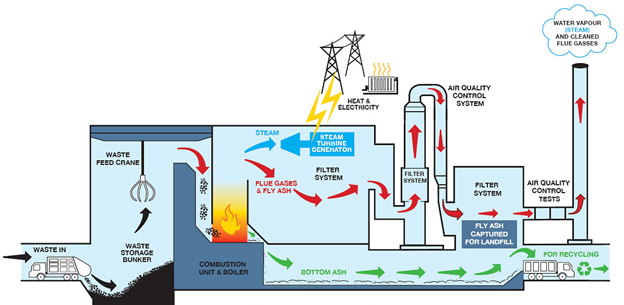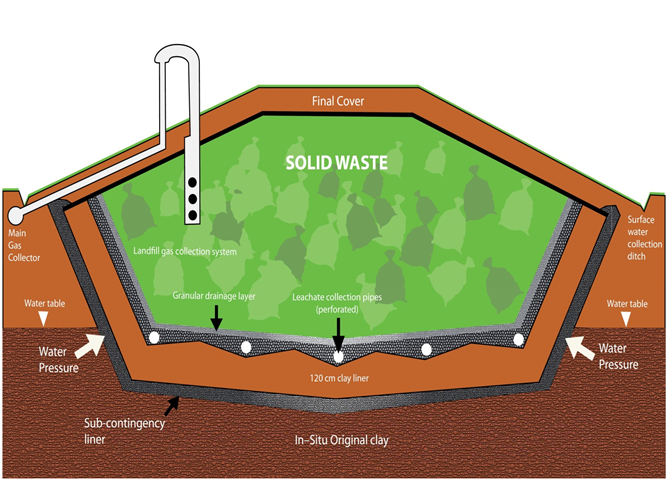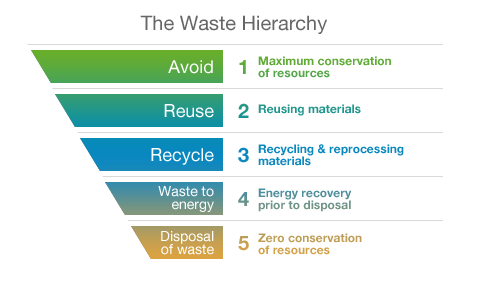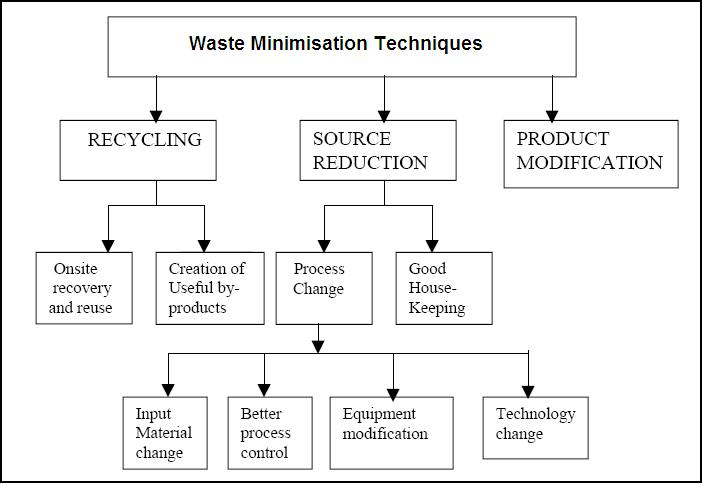Environmental concerns
Authors: Sean Cabaniss, [2014] David Park, [2014] Maxim Slivinsky, [2014] Julianne Wagoner, [2014] Michelle Spiezio [2015] , Pear Dhiantravan [2016]
Steward: David Chen, Jian Gong, and Fengqi You
Date Presented: Feb. 23, 2014
Overview
All industrial processes produce waste in some form that must be carefully handled and disposed of according to regulations set down by governments at varying levels. The key areas for consideration are emissions to the air, water, and land, smells, noise, and visual impact, and waste management. It is important to remember that pollution considerations are both a moral and legal obligation for any engineer or industry(Towler et. al (2012). Emissions from chemical plants are regulated by both local and federal governments. Plants are required to monitor and document waste streams discharged to the environment, maintain permits from local governmental agencies, and either pay fines or directly address any violations(Towler Powerpoint, 2010). Waste management can come in many forms to minimize the impact on the environment. Some key strategies include dilution and dispersion of the harmful chemicals, discharge into foul sewer water with permission from the appropriate authorities, physical treatment methods, chemical treatments, biological treatments, incineration, landfill at controlled sites, and dumping into the sea.
Human Health, Social and Economic costs
Environmental concerns associated with process plants encompass more than just air, land, and water pollution. There are also a variety of other indirect costs that should be considered, as they too can have a large impact on both the environment and company profit if not properly addressed. These costs are directly linked to all the types of pollution that a plant releases. Whether it is air pollution, water pollution, or even excess noise, it is important to minimize the impact of these discharges on the health of both the local community and the population as a whole, due to the far reaching effects of most types of pollution. Addressing pollution responsibly will also minimize social costs, those that are linked with how the public perceives the company. Being perceived positively by the public will minimize costs associated with having to boost company image and gain the trust of communities. Environmental stewardship also ties into economic costs. Having to pay for environmental compliance equipment may be expensive, but neglecting to do so will result in even larger legal fees and costs associated with cleaning up disastrous spills.
Human Health
The human costs associated with chemical plant pollution come in the form of endangerment to the health of people in local communities. Because chemical plants are not going to be fully contained, it is necessary to determine how those streams and pollutants that are emitted affect the surrounding population. Figure 1 shows the various effects of pollution on the human body. A few examples of this are: contamination of the local potable water supply if, for instance, chemicals in a retention pond leech out and into groundwater; release of particulate matter reducing the air quality of a community to the point where instances of asthma increase; and, the release of hazardous chemicals causing carcinogenic effects(EPA Website- Health Effects of Air Pollution).
Figure 2 below shows the world wide impact of air and water pollution as it relates to the impact of infectious disease malaria. The number of premature deaths from pollution is obviously quite high, however WHO currently estimates that the numbers are ever higher. WHO now estimates 7 million deaths annually linked to air pollution. This large number comes from new data which suggests that there is a strong link between air pollution exposure and cardiovascular diseases and cancer. Air pollution is also the cause of numerous respiratory diseases(WHO).Water pollution concerns that we hear about mostly have to do with biological pollutants, such as bacteria and parasites that cause illness. Water polluted with microorganisms causes 80% of all infectious diseases. (Environmental Pollution Centers-'Water Pollution Diseases). This, however, mostly comes from mistreatment of human waste, not from industrial pollution. Industrial chemical pollution is controlled by the EPA, thus the levels of chemicals industry can release into water is low enough to not cause any health issues in humans. However, there are still unknown health effects for a large number of chemicals.
The effects of polluted air and water supplies on human health are as numerous as the possible industrial sources of contamination. Each organic and inorganic compound has a unique systemic effect. Despite the existence of a number of these compounds in the human body, many systems are extremely sensitive to environmental changes increasing or decreasing the amount of mineral or chemical extant.
Humans may be exposed to water pollutants as immediately as in the form of drinking water and as indirectly as through the food chain. The former can directly be assessed for contaminants, while the latter is more difficult to monitor due to the involvement of many variables between the source water and the human consumer. Plants that grow near contaminated water sources can absorb harmful chemicals, which are then ingested by small animals and passed along the food chain to humans. The movement of these animals and their source of food is difficult to track, as is the balance of toxins entering and leaving their body. The effects of bad waste containment and water purification before expulsion into the environment can thus reach as far as people who live in entirely different areas.
Air pollutants that result from chemical processes can easily be inhaled by close inhabitants or even by populations downwind. As airborne waste enters the atmosphere, it immediately can diffuse and can reach as far as the other side of the world.3 Pollutants can additionally travel through air and settle onto food or water sources to be ingested. Less frequently do air pollutants affect a person through physical contact, but that is also a possibility especially in cases where someone has cuts or lesions on their skin (Kampa and Castanas, 2008).
Long-term effects arise if the unwanted pollutants are absorbed into the blood stream, from which they can access and accumulate on vital organs. The cardiovascular and respiratory systems were shown to be the most affected after exposure to particulate matter, which is produced by factory and power plant waste streams and incinerators, among other sources (Kampa and Castanas, 2008). Depending on the size of the particulate, it may or may not be able to enter lung alveoli by traveling through the respiratory tract. These particles can carry with them organic compounds, metals, carbon wastes, and toxic gases, which accumulate in tissues. This can cause mild to severe irritation as well as inflammation, constriction of airways, and increased susceptibility to infections. Accumulation of ions and small noxious gases can alter local or systemic pH, which is harmful as many enzymes and biological machinery are very sensitive to changes in acidity.
The body may excrete ingested toxins, however the path to excretion may suffer damages as well. A study of the physiological effects of the metals lead, arsenic, and cadmium showed adverse effects on the kidney where blood is filtered into urine. Metal deposition severely disrupts kidney function, as certain proteins and other molecules will bind to them and suffer a loss of function (Madden and Fowler, 2000).
Process designers can gain access to information about waste and effluent streams that are made in their plants, and can assess the dangers of the components in these streams according to EPA regulations as well as regulations within the local/ state community. The composition of these streams and the levels of particulate matter can be controlled by adding proper air filtration or wastewater treatment methods as described in the Treatment sections below. Although different locations may have different standards for pollutants, it is important to keep in mind that the plants and animals in these areas generally react to toxins in the same manner. Process designers are responsible for the ethical concerns that arise if standards are lowered and populations surrounding a plant are exposed to toxic levels of pollution, and should be mindful of these overarching safety concerns regardless of plant location. Below is a list of some chemical pollutants that might be of concern to process designers and their LD50.
Social
The social costs linked to environmental concerns relate to public perception of a company and its actions with regard to environmental stewardship, as well as the social impact on society. Any company that produces waste streams is going to be scrutinized by the public for the way these streams are handled. Companies caught or known for high pollution levels often receive bad press, which can also give investors a bad impression and hurt stock prices. It is to the advantage of the company, therefore, to prove to the public that every effort is being made to responsibly handle waste streams.
These costs can be the burden of both society and industry. In 2011, it is estimated by the NRDC that air pollution caused the loss of 3.4 million work days in the United States(NRDC). These lost work days combined with medical bills sum to a cost as high as $78 billion dollars. Social costs to industry can come in the form of money spent to improve company image. The amount varies based on situation, but can be very high, especially in the wake of an environmental disaster. A recent example of high social costs is the outcry in the wake of the BP oil spill. In 2012, BP and the Department of Justice reached a settlement where BP would pay $4.5 billion in fines. However, BP projects that the spill will cost around $40 billion due to all of the payments to not only settle claims, but to support efforts to rehabilitate the Gulf Coast ecosystems and businesses that (not mandated by the court). Additionally, BP has to work to continue to turn around the 35% reduction in stock prices since the spill(Huffington Post).
The Clean Air Act was established in 1970 to bring a conscientious effort to air pollution. It has undergone an amendment and several reviews, and is monitored for relevance and efficacy. It gives the Environmental Protection Agency the authority to establish national standards regulating air pollution and ensuring the safety of the people (EPA). Unfortunately, national boundaries for air quality cannot be as solidified as they are for water quality due to the rapid tendency of wind to affect other nations with one’s air pollutants. A study conducted in 2013 showed that pollution stemming from product exports in China contributes to a substantial percentage of sulfate pollution in the United States (Lin and Pan, et. al 2013). Differences between nations’ standards for waste treatment can cause disparities in global air care and national concern when retroactive treatment must be installed to purify leaked contaminants.
These disparities often stem from the differing societal standards between developed and developing countries. Without strong governmental motivation, the public lacks guidance in upholding quality standards. Formal education is another contributing factor, as spreading the use of treatment facilities requires that the users understand the health and environmental benefits of waste stream treatment (Jardim et al, 2012). Many underdeveloped countries may have some infrastructure for water recycling and treatment, however their efficacy depends on the contributions and participation of the public. In situations where low income is combined with a lack of general education, much of the public would choose not to pay for wastewater treatment because they cannot see its utilitarian effects on the future (Jardim et al, 2012).
An additional effect of insufficient education is that children and adults in these areas are unaware of the contaminants in their water source. This leads to improper pretreatment, which can cause diseases and other harmful physiological effects (Jardim et. al, 2012).
Process designers can address these challenges by catering wastewater treatment infrastructure to the needs of the society, taking into account the level of urbanization and population growth trends (Giovanni et al, 2012). These two factors continually strain the environment and clean water supply, putting many at risk of only having access to poorly sanitized drinking water. While well developed countries may benefit from fully centralized wastewater treatment systems, developing countries might require a more decentralized approach to cater to the spread of the population and to increase accessibility to treatment plants.
Economic
The main economic costs come from the installation and operation of environmental control equipment(Turton et al, 2003). These costs are of separation equipment, such as settling tanks, electrostatic precipitators, and distillation columns, as well as disposal equipment, such as incinerators and reactors that neutralize or oxidize a waste stream. Another cost that companies must incur is that of the removal of these wastes. Companies will often pay third party waste management companies to take waste streams and dispose of them, through means such as burial and placing in a landfill, for example. There are also the costs of cooling towers and noise abatement measures to take into consideration. The cost of water treatment systems typically accounts for around 1.3% of fixed-capital investment, while waste disposal facilities cost up to 2% of fixed-capital investment(Peters et al, 2003).
The cost of not taking the environment into consideration when designing a process can far outreach that of the equipment, however. If a company does not follow regulations, they incur legal expenses as a penalty. Additionally, failure to comply can a high cost associated with poor public perception of the company. Bad press and public protests can lead to a large loss in profit(Towler et al, 2013). For example, just to avoid strict air standards that would impose costs of better pollution control equipment, power companies spent $67 million between 2010 and 2012 lobbying congress against clean air regulations(NRDC).
In the long run, it can often be in a company's best interest to take environmental factors into consideration. Optimizing a process, to reduce waste, results in less money that needs to be spent on waste disposal. Additionally, using recycle streams effectively may reduce the cost of the inputs to the process. Finally, if a process is designed in such a way (Seider 2004).
Fiscal disparities between national governments as well as public socioeconomic status contribute greatly to the gap between their air and water quality standards. There is a clear lack of cohesion in the organization of wastewater collection and treatment in several developing countries (Jardim et. al, 2012). Population growth combined with insufficient infrastructure for waste treatment devolves into an overall inability to maintain, regulate, or motivate air and water quality care. This is an economic issue in its core, with towns and countries unable to obtain the resources necessary to install sufficient regulatory methods. As wastewater treatment is an effort that can most effectively be maintained by the efforts of everybody in a population, fiscal inequalities pose a burden to the efficacy of current infrastructures.
By designing integrated systems that are appropriately sized for the population that they serve, the efficiency and efficacy of wastewater treatment can be greatly improved (Bieker et al, 2010). The figure below outlines a possible schematic for a semicentralized system whereby preliminary sorting occurs on a house-by-house basis, and larger local service plants perform the final large-scale treatments. The authors of this proposed scheme suggest that semicentralized systems such as this one not only provide increased breadth in treatment capabilities across populations, but also decreases energy and clean water usage by servicing local populations based on their needs and consumption.
The EPA has provided estimates for the annual cost and operational costs of potential wastewater management systems for a rural community of approximately 450 people. Smaller communities are hypothesized to benefit most from decentralized systems, and their study confirmed that this is so. To fund a centralized system, the annual cost would be approximately $216,850- $342,500 with an additional average operational cost of $35,000. The total capital cost of a centralized system can span from $2.3M to $3.8M. Decentralized small cluster or on-site systems, on the other hand, yield a capital cost estimate of $510,000 with very low operational and annual costs. This analysis is specific to the hypothetical rural area that they assumed, but illustrates the possibility of dramatically decreasing costs when the treatment system is tuned to the local community (Bieker et al, 2010).
Types of Pollution and Treatment
Environmental concerns associated with process plants encompass more than just air, land, and water pollution. There are also a variety of other indirect costs that should be considered, as they too can have a large impact on both the environment and company profit if not properly addressed. These costs are directly linked to all the types of pollution that a plant releases. Whether it is air pollution, water pollution, or even excess noise, it is important to minimize the impact of these discharges on the health of both the local community and the population as a whole, due to the far reaching effects of most types of pollution. Addressing pollution responsibly will also minimize social costs, those that are linked with how the public perceives the company. Being perceived positively by the public will minimize costs associated with having to boost company image and gain the trust of communities. Environmental stewardship also ties into economic costs. Having to pay for environmental compliance equipment may be expensive, but neglecting to do so will result in even larger legal fees and costs associated with cleaning up disastrous spills.
Noise Pollution
Noise pollution is any unwanted or disturbing sound that diminished quality of life(Ulrich 1984).
Causes & Effects
Equipment that are likely to be noisy are compressors, fans, burners, and steam relief valves(Towler et. al (2012). Whereas this unwanted noise may often be considered just an annoyance, there are studies that link elevated noise to health issues. For example, being exposed to unwanted noise can lead to an increase in stress and disruption of sleep, thus leading to increased blood pressure. Exposure to high levels of sound can lead to Noise-Induced Hearing Loss (NIHL)(Towler et. al (2012). Sound is measured in decibels (dB) and is determined by the following expression:
RMS sound pressure is equal to the localized change in atmospheric pressure caused by sound waves, measured in Pa. Sound meters determine noise level as a human ear would, providing measurements in dB(A) units. The “A” term corresponds to the weighting used by the meter to mimic the human ear. Permanent damage can be caused at sound levels above 85 dB(A), and ear protection is customarily worn in areas where levels are around 80 dB(A) and above(Wikipedia page-Sound Pressure).
Treatment
To mitigate the adverse human effects of noise pollution, the EPA has included provisions in the Clean Air Act, the noise Control Act of 1972 and the Quiet Communities Act of 1978. However, the responsibility of noise control is mainly handled at the State and local level(ulrich 1984).
Some design decisions can be made to reduce the effects of noise on humans. Noisy equipment should not be placed near rooms that are often occupied. Additionally, rooms can be insulated to mitigate the length which the noise travels. If workers are to be near noise, they should wear earplugs to reduce the impact. Finally, choosing a plant location that is far from communities will reduce the amount of people exposed to any loud noises.
Thermal Pollution
Thermal pollution relates to the heat released by a plant into the environment. This often comes from water that was used to cool down a process and then released into the environment.
Causes & Effects
The largest concern with regards to thermal pollution is water quality. The temperature of water directly relates factors such as density, surface tension, and to the solubility of gases in the water. The most important consideration is the solubility of oxygen in water. Dissolved oxygen in water is essential in maintaining aquatic life. Thus changing the temperature of water due to thermal pollution can alter water ecosystems. An additional concern is that increased water temperatures lead to a reduction in capacity for organic wastes assimilation. Figure 3 shows a summary of the effects of thermal pollution on water systems.
Treatment
Because of the negative effects of thermal pollution, and federal water temperature standards, design engineers must employ the use of various process technologies to mitigate thermal pollution. Options for reducing temperatures of water streams are: cooling towers, cooling ponds, and spray ponds. All of these technologies use the principles of heat transfer across a water-air interface, thus the heat from the water is transferred to air, which can be released into the environment. Another consideration is to recycle the heat. Hot water or fluid waste/effluent streams can be used in a heat exchange network to transfer heat to an inlet stream that requires heating before entering a process.
Air Pollution
Air pollutants can be either gases or particulate matter suspended in an effluent air stream. Some examples are: CO2, sulfates, nitrates, particulates (PM10, PM2.5), Volatile Organic Compounds (VOC) and, less commonly, chlorine compounds(Towler et. al (2012).
Causes & Effects
These pollutants often come from fired heaters, boilers or flares. These wastes are often under careful scrutiny from governments as well as the public since gases being released from towers are often the easiest forms of pollution for a casual observer to see.
Emissions to the air can be particularly dangerous because, if left unchecked, they can have far reaching consequences. Historically, the focal points for air emissions have been the effects on acid rain, ozone and greenhouse gases. Lately, greenhouse gases have been the most scrutinized due to growing concerns of global warming.
Treatment
Air emissions must be treated before being released into the atmosphere, especially given the recent emphasis on green processes and the growing alarm with regards to global warming. Due to the properties of gases, air pollution control can be the most expensive and energy intensive. Typically, there are two main classifications of air pollution control equipment: those associated with removing gaseous pollutants from streams to be released into the air and those that can physically remove particles from these streams.
Equipment chosen to remove a gaseous pollutant depends on whether the gas is easily reacted into something that is less harmful to the environment. Noxious elements are often removed by absorption, using a gas scrubber which utilizes a liquid solvent, or by adsorption, using a gas adsorber utilizing either a liquid or solid as the adsorber for the pollutant being removed(Peters et al, 2003). An important note is that these pieces of equipment often do not render the pollutant harmless, but simply change the form from gas to liquid or from gas to solid, both of which needs further treatment. For those pollutants which can be reacted into something less harmful, equipment such as reactors and incinerators are used. For example, combustible vapors are often burned in either a direct incinerator or in a catalytic incinerator, to increase the efficiency of the burning reaction. However, these incinerators often require very high operating costs.
For the removal of particles from gas streams, there is a wide variety of possible equipment, chosen based on particle size and characteristics, as shown in Figure 4 above(Peters et al, 2003). Mechanical collectors are generally used when particle sizes are large. Some mechanical collection equipment are: settling chambers, which are driven by gravity; cyclones, which make use of centrifugal forces; and bag filters, which collect particles from the gas by interception on the fabric surface of the bag(ulrich, 1984). Mechanical collectors are all dry methods of particle removal. There are also a variety of wet methods that can be employed to rid gases of particles. Wet methods such as a spray tower and Venturi scrubber rely on the collision of the particles with water to remove the particles from the gas, as seen in Figure 5. A final method of particulate removal is an electrostatic precipitator (ESP), Figure 6. An ESP will charge the particles in the gas by applying a high voltage, then allow these charged particles to be attracted to oppositely charged collection plates(Peters et al, 2003). ESPs are useful for removing ultra-fine particles from corrosive gas streams, but are often sensitive to the properties of the particle. Additionally, the method of using rapping to remove the particles from the collection plates is rudimentary and often causes maintenance issues(ulrich, 1984).
Water Pollution
Types of water pollutants are: chemicals, such as oil; suspended solids, such as metals and biological materials; and dissolved (aqueous) materials, such as ions.
Causes & Effects
Water pollution mainly comes from agriculture, urban runoff, and industry, as shown in Figure 7. Many of these chemical pollutants are regulated by the EPA, but there are still many that aren't. This is due to the fact that there simply is not comprehensive information on the effects of these chemicals to the environment and humans. For chemical engineering, industrial water pollution is the most applicable. This typically comes from three streams: process waste, utility waste and run-off streams. Process waste streams are the unwanted side products of reactions and include salt water, hydrocarbon contaminated water, biologically contaminated water, and water with too high or low pH. Utility waste is mainly produced from cooling tower water blowdown. The purpose of blowdown is to prevent a buildup of salts in the towers, but produces a stream of contaminated water. Finally, run-off streams come from rain water, hydrant flushing and equipment washing.
Liquid wastes are typically not as far reaching as gaseous waste, but can be much more devastating. Ecosystems can be destroyed from poor wastewater policies. Local populations can suffer from a lack of clean drinking water or dying wildlife in the area. The BP oil spill was a highly visible incident that showed how much damage can be done by water borne pollutants.
Aqueous wastes can be the most immediately harmful to the environment and people living nearby and must be sent immediately to an effluent treatment. Some of the most common, harmful water contaminants are ammonia, salts from deionizers, hydrocarbons, spent acids, caustics, and various forms of biological contamination. Utilities on-site can also create large wastewater flows that must be purged in order to prevent solid buildups. The most efficient way to deal with contaminated runoff is to collect and purify it on-site before disposing of it(Peters et. al, 2003).
Treatment
The main factors that usually have some sort of legislative constraints are pH levels, suspended solids, toxicity, and biological oxygen demand. Oxygen demand is often under looked as a form of pollution because there is rarely visible evidence that something is wrong in the stream. However, many local governments mandate that the water leaving a plant must have enough oxygen to sustain aquatic life before being released.
Liquid wastes are usually flammable and can be burned in an incinerator as long as care is taken to insure the temperatures are high enough to destroy the harmful compounds. This only shifts the problem, however, as it creates gaseous wastes.
Wastewater that contains large particles, either floating or suspended, will usually be first treated by simply skimming off or pulling out the large masses of particles. Following this, wastewater will be sent to a sedimentation basin to allow the particles to settle due to the force of gravity. The sludge that forms on the bottom of the basin is removed with sludge scrapers. For smaller particles that are not settled out of the water, a rapid sand filter or multimedia (usually sand and anthracite) filter, shown in Figure 8, can be used.(Davis, 2010). For very small particles, membrane processes can be employed. These include ultra-filtration, which uses exclusion of particles based on size, reverse osmosis, shown in Figure 9, which excludes based on both size and particle properties, and electrodialysis, which is used to remove ionic species from the water.(Peters et. al, 2003).
To treat water contaminated with organic matter, microorganisms can be used. The microorganisms break down the organic matter, either aerobically or anaerobically depending on the organism. Aerobic biological processes either used activated sludge, shown in Figure 10, where biological growths are mixed in the wastewater and the resulting suspension is separated by gravity, or the fixed-film method, in which wastewater trickles over a biological film(Peters et. al, 2003).
Chemical treatment of water is generally used to remove color, odor, acids and alkalies, heavy metals, colloids, and oil. To remove colloids, coagulation is often used. In coagulation, chemicals are added to the water to break down the electrostatic double layer or the colloidal particles, essentially to neutralize the charge of the particles, allowing them to combine during flocculation(davis 2010).To treat acid and alkaline waste, lime and sulfuric acid are often used(Peters et. al, 2003). Converse to this, distillation or salt precipitation methods can be used to recover the acid or alkali. To disinfect the water, chlorine or ozone are often used. Ozone, in addition to disinfection, is also useful for color, taste, and odor removal from the water.
Land Pollution
Land pollution is any solid wastes that requires disposal. Solid wastes are generally identified as flammable, toxic, corrosive or reactive. Waste containing any of these characteristics must be specially handled to ensure as little damage to the local environment as possible.
Causes & Effects
Left unchecked, large amounts of flammable waste could ignite and become very difficult to control. Toxic, corrosive or reactive materials have averse affects to any local populations, often causing major health problems in humans and animals alike. Solid waste in a landfill can create chemical leachates which, if improperly handled, can seep into the ground and into groundwater.
Treatment
Solid, hazardous wastes are generally the easiest to control, but can also be the most difficult to safely discard; once created they can last much longer and do more damage than liquid or gaseous pollution. Table 1 below shows various types of solid wastes and how they can be treated.
Table 1 shown above introduces several forms of solid waste disposal. The main types of disposal are recycling, chemical conversion, incineration, pyrolysis, and landfill(Peters et. al, 2003). Chemicals can be recovered from solids through extraction or stripping, while valuable solids can be recovered through a variety of methods such as flotation, electrical conductivity, or hand picking. Recycling these products or even selling them can often save company money in the long run. Chemical conversion of solid waste can often be used to convert the waste into something less harmful or sellable. Incineration is used to create a residue that is much smaller and more acceptable for landfill application. Incineration can be expensive, but if done properly can potentially recover some fuel value through the generation of steam. Pyrolysis, or the heating of the waste in an air-free chamber, is an alternative to incineration that avoids a lot of the air pollution issues associated with incineration,(Peters et. al, 2003). as the pollutants produced are contained and can be treated. Figure 11 shows pyrolysis of solid waste.
Landfills are useful for disposing large quantities of waste, but if the contents are legally classified as "hazardous", the waste must go through a pretreatment process in order to reduce the contaminants to an acceptable level. Additionally, proper lining of the landfill must be installed to prevent leachates that seep from the landfill and into groundwater. With the proper set-up, landfills can be used as a source of methane gas. A landfill diagram depicting both the lining requirements and a methane collection system is shown below in Figure 12.
Waste Minimization
Chemical engineers need to keep several environmental considerations in mind when designing processes. During the design of the process, the toxicities of all the products, byproducts, and wastes produced by the system must be considered. Then, the reaction pathway that minimizes toxic components should be chosen whenever possible.(Biegler et al, 1997). Emphasis must also be put on designing processes that operate at a nominal steady stare. Avoiding transient conditions, such as start-up or accidents, also avoids the production of excess waste(Biegler et al, 1997).
The general 5-step process for waste minimization can be summarized as: 1) Identify waste components for regulatory impact. 2) Identify waste streams for size and economic impact. 3) List the root causes of the waste streams. 4) List and analyze modifications to address the root causes. 5) Prioritize and implement the best solutions(Towler et al, 2013). The hierarchy of waste management approaches is: 1) source reduction by maximizing conservation, 2) reusing materials, 3) recycling, 4) energy recovery from waste, and 5) disposal. This hierarchy is shown in Figure 13. It is evident that avoiding pollution is the best route, but, this is not usually an option.
When designing a process, emphasis should be placed on reducing the source of pollution in the first place. There are a variety of strategies for reducing that source of waste. Some of these are to reduce the concentration of impurities in feed streams, protect catalysts and adsorbents from poisoning and deactivation, and to eliminate the use of extraneous materials, such as solvents. Other strategies are to improve the efficiency of the process, by increasing recovery of separations because higher purity streams means smaller waste formation. Finally, altering background processes of the plant to be more efficient can save waste. For example, using a cleaner fuel as an energy source or a more environmentally friendly supplier reduces environmental footprint(Towler et al, 2013).
A good design will seek to minimize, recycle, and make use of segregated waste streams in order to satisfy the demands of the waste market(Seider 2004). Optimization is a powerful tool for waste minimization because it cuts down on toxic materials as well as improving the overall system. Optimization can be used to account for environmental impact, such as the effects of carbon monoxide or other greenhouse gases. Recycling not only reduces the amount of waste, but also provides cost savings for a company. For example, recovering heat from wastewater can eliminate both thermal pollution and water pollution, while producing energy inputs if the suspended solids can be fermented to produce fuels. Processes should also be designed, if possible, to use materials that can are considered waste to other processes. If waste produced is considered a valuable product to another process, the waste can be sold or utilized, thus avoiding some of the costs associated with treatment and disposal. Figure 14 depicts a brief methodology for waste minimization.
Legislative Action
1972 Federal Water Pollution Control Act
The US Water Pollution Control Act set forth three major new regulations in an effort to keep toxic contaminants from getting into water supplies. Its goal was to achieve clean water for swimming, boating, and protecting fish and wildlife by 1983. This legislation said the EPA would set water quality standards for pollutants in surface water, set effluent guidelines for each industrial sector, and that it is unlawful to discharge any pollutant into navigable waters without a permit( U.S. Fish and Wildlife Service).
Resource Conservation and Recovery Act (RCRA)
The ultimate goal of this act is to protect the groundwater from contamination. The act addressed waste management from "cradle to grave". It identified wastes on regulatory lists or if it has a certain characteristic level of flammability, toxicity, corrosivity, or reactivity. The act also specified how hazardous wastes must be labeled and tracked in transport as well as the treatments required for low levels of contaminants(EPA Website "Resource Conservation and Recovery Act).
Example Environmental Design Problem
Volatile Organic Compound Abatement(Becker, 1994)
The 1990 Clean Air Act mandates a reduction in emissions of volatile organic compounds (VOC). Any VOC emission sources exceeding 10tons/year must retrofit abatement processes with the best available control technology (BACT).
A paint spraying plant emits VOCs from vents in the paint spray booths. The stream contains primarily toluene, methyl ethyl ketone (MEK), and xylene, with small impurities of silicone and phosphorus. The concentration of VOCs in the dryer effluent varies between a minimum of 0.3 wt% VOC and a maximum of 1.2 wt% VOC with an approximate composition of 50% toluene, 25% MEK, and 25% xylene.
The painting company has commissioned you to evaluate three different technologies for a reduction in VOCs: thermal incineration, catalytic incineration, and carbon absorption and destruction of the VOCs. The low quality steam can be used by a nearby bottle washing plant.
Design an emission control plant for 50,000 scfm of vent gas at 100F and 25% relative humidity for 99% removal. The plant is located in Dearborn, Michigan, and the paint spray booths operate on a single 12-hour shift per day. Include the necessary start-up controls. The available fuel is natural gas or oil. Calculate the capital and operating cost and the $/lb or ton of VOC removed. Compare the three processes and recommend which is most suitable for this application.
Conclusion
Nearly all industrial chemical processes have pollution in one form or another. There are several sources and compounds of waste in all phases to be aware of and to know how to dispose of properly. A proper understanding of these hazardous compounds and materials as well as the effects these pollutants can have is essential, especially as an engineer. A chemical engineer's duty is to ensure that the waste, whether a gas, liquid, or sold is disposed of or recycled in a responsible manner and according to the local and federal guidelines. Proper waste management not only reflects well on a company and its engineers, but also can have lasting benefits to profits and the well being of locals in the area. On the other hand, reckless waste handling policies are not only dangerous for a plant and those around it, but are in danger of serious repercussions from the government and in the EPA. Finally, engineers have a moral obligation to uphold certain standards even when working in countries with less strict waste management standards.
References
Towler, G.P. and Sinnot, R. (2012). Chemical Engineering Design: Principles, Practice and Economics of Plant and Process Design. Elsevier.
Towler, G.P. (2012). Chemical Engineering Design, PowerPoint presentation.
EPA Website Health Effects of Air Pollution http://www.epa.gov/region07/air/quality/health.htm
WHO, 7 million premature deaths annually linked to air pollution, March 2014 http://www.who.int/mediacentre/news/releases/2014/air-pollution/en/
Environmental Pollution Centers, Water Pollution Diseases http://www.environmentalpollutioncenters.org/water/diseases/
Wikipedia web page,Pollution http://en.wikipedia.org/wiki/Pollution
Breath Project,Air Pollution World’s Top Killer by 2050 http://breatheproject.org/news/2012/03/
Altman The Price Of Pollution Politics: Eight Companies Attacking Clean Air Standards and the Toll on America’s Health NRDC: June 2012. http://www.nrdc.org/air/files/Price-of-Pollution-Politics.pdf
B. Skoloff, J. Wardell. BP Oil Spill Cost Hits $40 Billion, Company Returns To Profit Huff Post Green. http://www.huffingtonpost.com/2010/11/02/bp-oil-spill-costs-hit-40_n_777521.html
R.T. Turton, R.C. Bailie, W.B. Whiting, J.A. Shaeiwitz, Analysis, Synthesis, and Design of Chemical Processes, Prentice Hall: Upper Saddle River, 2003.
M.S. Peters, K.D. Timmerhaus, Plant Design and Economics for Chemical Engineers, 5th Ed., McGraw-Hill: New York, 2003.
Seider, W.D. (2004). Process Design Principles: Synthesis, Analysis, and Evaluation, Wiley: New York.
Ulrich, A Guide to Chemical Engineering Process Design and Economics, Wiley: New York, 1984.
Wikipedia page, Sound Pressure http://en.wikipedia.org/wiki/Sound_pressure
Tutor Vista Effects of Thermal Pollution http://www.tutorvista.com/biology/effects-of-thermal-pollution
VITO,Gas scrubbing - general http://emis.vito.be/techniekfiche/gas-scrubbing-general?language=en
IHS GlobalSpec,Electrostatic Precipitators Information http://www.globalspec.com/learnmore/manufacturing_process_equipment/air_quality/electrostatic_precipitators
Environmental Working Group - National Drinking Water Database Drinking water pollution has many sources December 2009. http://www.ewg.org/tap-water/sourcesofwaterpollution.php
D. Schmitt, C. Shinault. Rapid Sand Filtration Virginia Tech Department of Civil Engineering, 1998. http://www.webapps.cee.vt.edu/ewr/environmental/teach/wtprimer/rapid/rapid.html
M.L. Davis, Water and Wastewater Engineering, Professional Edition, McGraw Hill: New York, 2010.
Hydrocomponents & Technologies Inc.,About Reverse Osmosis http://www.hcti.com/sm/aboutro/aboutro.html
ChemSearch,Biological Wastewater Treatment Systems https://www.chemsearch.my/bioamp/Pages/BiologicalWastewaterTreatment.aspx
Arc21 Energy from Waste (EfW) http://www.arc21.org.uk/opencontent/?itemid=27§ion=Residual+Waste+Project
Ohio Wesleyan University - Environmental Geography Landfill Facts http://www.arc21.org.uk/opencontent/?itemid=27§ion=Residual+Waste+Project
Biegler, I.E. Grossmann, A.W. Westerberg, Systematic Methods of Chemical Process Design, Prentice-Hall: Upper Saddle River, 1997.
Burnie City Council Waste Minimization Hierarchy http://www.burnie.net/Environment/Resource-Recovery-Initiatives/Waste-Minimisation-Hierarchy
Partha Das Sharma Blog-Keeping World Environment Safer and Greener Waste Reduction and Raw material conservation are the most important functions in Waste Management https://saferenvironment.wordpress.com/2009/01/01/waste-reduction-and-raw-material-conservation-are-the-most-important-functions-in-waste-management-saves-environment-and-money/
U.S. Government page "Digest of Federal Resource Laws of Interest to the U.S. Fish and Wildlife Service" Digest of Federal Resource Laws of Interest to the U.S. Fish and Wildlife Service.
EPA Website "Resource Conservation and Recovery Act (RCRA)" http://www.epa.gov/agriculture/lrca.html
Robert Becker, Volatile Organic Compound Abatement, Environex, January 1994.
M. Kampa and E. Castanas, Human Health Effects of Air Pollution http://www.sciencedirect.com/science/article/pii/S0269749107002849
E. F. Madden and B. A. Fowler, Mechanisms of Nephrotoxicity from Metal Combinations: A Review http://www.tandfonline.com/doi/abs/10.1081/DCT-100100098?journalCode=idct20
Lin and Pan, et. al, China’s international trade and air pollution in the United States http://www.pnas.org/content/111/5/1736.short
A. M. Jardim, et. al, Economics of Wastewater Treatment: cost-effectiveness, social gains and economic status http://businessperspectives.org/journals_free/ee/2012/ee_2012_03_Junior.pdf
S. Bieker, P. Cornel, M. Wagner, Semicentralised supply and treatment systems: integrated infrastructure solutions for fast growing urban areas Water Sci. Technol., 61 (2010), pp. 2905–2913 http://wst.iwaponline.com/content/ppiwawst/61/11/2905.full.pdf
L. Giovanni, Annamaria Volpi Ghirardini, Francesco Avezzù, To centralise or to decentralise: An overview of the most recent trends in wastewater treatment management, Journal of Environmental Management, Volume 94, Issue 1, February 2012, Pages 61-68, ISSN 0301-4797. http://www.sciencedirect.com/science/article/pii/S0301479711002751
